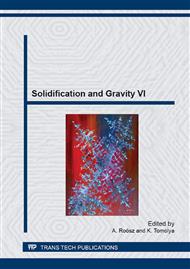[1]
I. Maxwell, A. Hellawell, A simple model for grain refinement during solidification, Acta metall. 23 (1975) 229-237.
DOI: 10.1016/0001-6160(75)90188-1
Google Scholar
[2]
M. Rappaz, C.A. Gandin, Probabilistic modelling of microstructure formation in solidification processes, Acta Metall. 41 (1993) 345-360.
DOI: 10.1016/0956-7151(93)90065-z
Google Scholar
[3]
M.A. Easton, D.H. StJohn, A model of grain refinement incorporating alloy constitution and potency of heterogeneous nucleant particles, Acta Mater 49 (2001) 1867-1878.
DOI: 10.1016/s1359-6454(00)00368-2
Google Scholar
[4]
M.A. Easton, D.H. StJohn, An analysis of the relationship between grain size, solute content, and the potency and number density of nucleant particles, Metall Mater Trans A 36 (2005) 1911-(1920).
DOI: 10.1007/s11661-005-0054-y
Google Scholar
[5]
A. L Greer et al, Modeling of inoculation of metallic melts: application to grain refinement of aluminium by Al-Ti-B, Acta Materialia 48 (2000) 2823-2835.
DOI: 10.1016/s1359-6454(00)00094-x
Google Scholar
[6]
Greer Al, Grain refinement of alloys by inoculation of melts, Phil. Trans. R. Soc. Lond. A 361 (2003) 479-494.
Google Scholar
[7]
T.E. Quested, A.L. Greer, Grain refinement of Al alloys: Mechanisms determining as-cast grain size in directional solidification Acta Mater. 53 (2005) 4643-4653.
DOI: 10.1016/j.actamat.2005.06.018
Google Scholar
[8]
M. Johnsson: Ph.D. Thesis, Stockholm University, Stockholm, (1993).
Google Scholar
[9]
J.A. Spittle, S. Sadli, Effect of alloy variables on grain refinement of binary aluminium alloys with Al-Ti-B, Materials Science and Technology 11 (1995) 533-537.
DOI: 10.1179/mst.1995.11.6.533
Google Scholar
[10]
H. Men, Z. Fan, Effects of solute content on grain refinement in an isothermal melt, Acta Materialia 59 (2011) 2704-2712.
DOI: 10.1016/j.actamat.2011.01.008
Google Scholar
[11]
D. Shu, B.D. Sun, J. Mi, P.S. Grant, A quantitative study of solute diffusion field effects on heterogeneous nucleation and the grain size of alloys, Acta Materialia 59 (2011) 2135-2144.
DOI: 10.1016/j.actamat.2010.12.014
Google Scholar
[12]
D.H. StJohn, M. Qian, M.A. Easton, P. Cao, The interdependence theory: the relation between grain formation and nucleat selection, Acta Materialia 59 (2011) 4907-4921.
DOI: 10.1016/j.actamat.2011.04.035
Google Scholar
[13]
Trivedi R, Kurz W, Solidification microstructures – A conceptual approach, Acta Mater 42 (1994) 15-23.
Google Scholar
[14]
Kurz W, Fisher DJ. Fundamentals of solidification. 3rd edn. Trans Tech Publications; Switzerland, (1992).
Google Scholar
[15]
Q. Du, Y.J. Li, An extension of Kampmann-Wagner Numerical model towards as-cast grain size prediction of multicomponent aluminum alloys, submitted to Acta Materialia.
DOI: 10.1016/j.actamat.2014.03.028
Google Scholar


